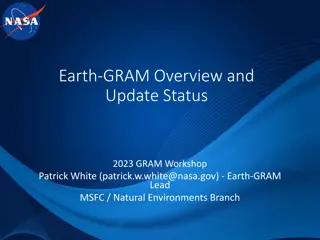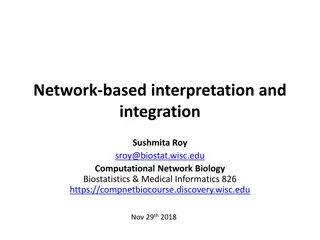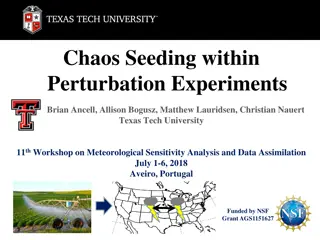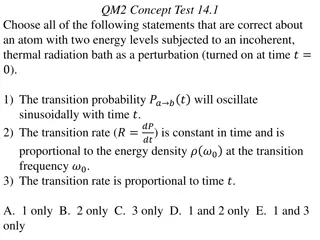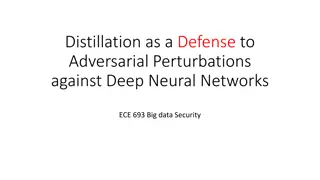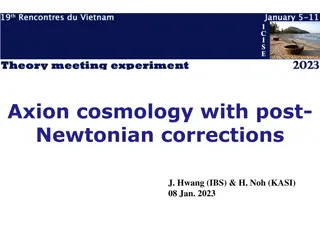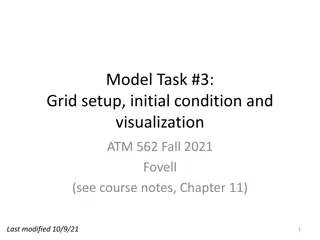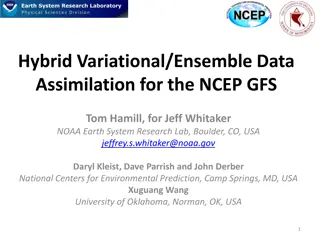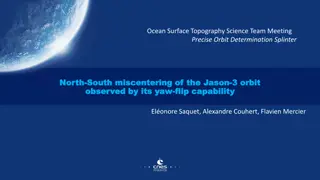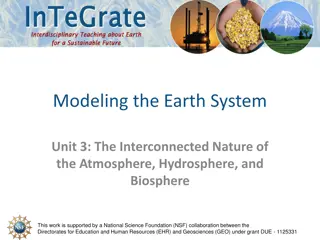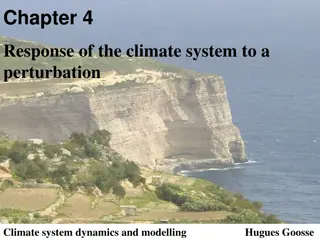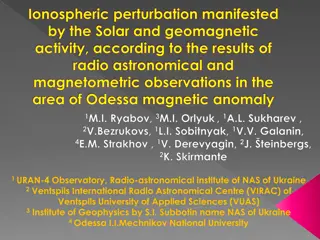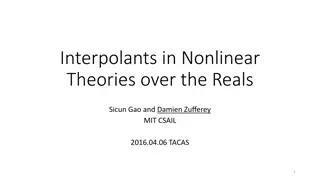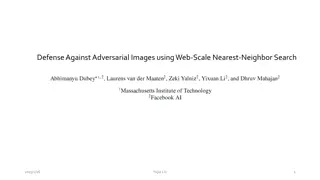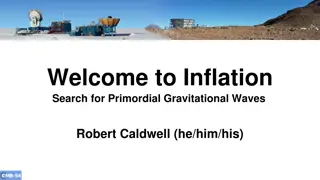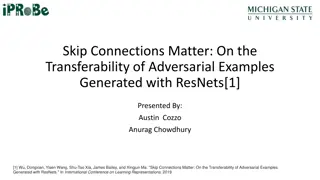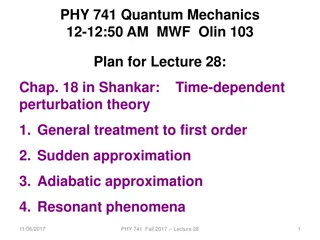Enhancing Counterfactual Explanations for AI Interpretability
Explore how to improve interpretability of AI models through generating counterfactual explanations with minimal perturbations and realistic, actionable suggestions. Addressing limitations of current methods and the need for a more flexible generative framework to ensure explanations are clear, conc
5 views • 13 slides
Earth-GRAM Overview and Updates 2023
Earth-GRAM is a global reference atmospheric model providing monthly mean and standard deviation data for various atmospheric variables. It is used in engineering for dispersion simulations but is not a forecasting model. Updates to Earth-GRAM include the Modern Era Retrospective Analysis, a global
1 views • 19 slides
Network Perturbations in Computational Biology
Network-based interpretation and integration play a crucial role in understanding genetic perturbations in biological systems. Perturbations in networks can affect nodes or edges, leading to valuable insights into gene function and phenotypic outcomes. Various algorithms, such as graph diffusion and
1 views • 55 slides
Observational Constraints on Viable f(R) Gravity Models Analysis
Investigating f(R) gravity models by extending the Einstein-Hilbert action with an arbitrary function f(R). Conditions for viable models include positive gravitational constants, stable cosmological perturbations, asymptotic behavior towards the ΛCDM model, stability of late-time de Sitter point, a
1 views • 12 slides
Investigating Chaos Seeding in Perturbation Experiments
This research project conducted at Texas Tech University delves into the effects of chaos seeding within perturbation experiments on atmospheric conditions, with a focus on local and nonlocal modifications resulting from factors such as irrigation, wind farms, and urban development. By analyzing tin
0 views • 24 slides
Quantum Mechanics Concept Tests 14
Explore quantum mechanics concepts related to atoms, energy levels, perturbations, transition probabilities, and emission rates. Understand the behavior of two-level systems under various perturbations and the dynamics of transitions in hydrogen atoms. Dive into calculations involving transition rat
0 views • 7 slides
Distillation as a Defense Against Adversarial Perturbations in Deep Neural Networks
Deep Learning has shown great performance in various machine learning tasks, especially classification. However, adversarial samples can manipulate neural networks into misclassifying inputs, posing serious risks such as autonomous vehicle accidents. Distillation, a training technique, is proposed a
3 views • 31 slides
Robustness to Adversarial Examples in Machine Learning
Explore the vulnerability of machine learning models to adversarial examples, including speculative explanations and the importance of linear behavior. Learn about fast gradient sign methods, adversarial training of deep networks, and overcoming vulnerabilities. Discover how linear perturbations imp
0 views • 37 slides
COTEKINO Priority Project Summary
COTEKINO Priority Project involved developing and testing perturbation methodologies for convection-permitting ensembles across various operational weather services. Tasks included deriving perturbations, testing models, and coordinating with different agencies. The project aimed to enhance forecast
1 views • 9 slides
Axion Cosmology with Post-Newtonian Corrections
Exploring axion cosmology with post-Newtonian corrections, this study delves into linear density perturbations for dust, the role of axion as a cold dark matter candidate, and fully nonlinear perturbation formulations. It addresses continuity, momentum conservation, and quantum stress to identify ke
0 views • 22 slides
Atmospheric Modeling Task with Initial Conditions and Grid Setup
Create a model grid with 2D arrays for prognostic variables, set initial dry and adiabatic environmental conditions, introduce thermal and pressure perturbations, and visualize using GrADS. Define variables like velocities, perturbation temperature, and pressure fields, along with base state variabl
0 views • 27 slides
Density Functional Theory in Computational Chemistry
Dive into the formalism and applications of Density Functional Theory (DFT) through a comprehensive review of basic theory, equations, and numerical implementations. Explore concepts like Time-Dependent DFT (TDDFT) and Linear Response formalism, and discover its applications in studying plasmons, co
1 views • 26 slides
Wavelet-based Scaleograms and CNN for Anomaly Detection in Nuclear Reactors
This study utilizes wavelet-based scaleograms and a convolutional neural network (CNN) for anomaly detection in nuclear reactors. By analyzing neutron flux signals from in-core and ex-core sensors, the proposed methodology aims to identify perturbations such as fuel assembly vibrations, synchronized
3 views • 11 slides
Hybrid Variational/Ensemble Data Assimilation for NCEP GFS
Hybrid Variational/Ensemble Data Assimilation combines features from the Ensemble Kalman Filter and Variational assimilation methods to improve the NCEP Global Forecast System. It incorporates ensemble perturbations into the variational cost function, leading to more accurate forecasts. The approach
1 views • 22 slides
Continuity Analysis of Programs
This content delves into the concept of continuity analysis in programs, focusing on aspects like uncertainty, robustness, and infinitesimal changes in inputs and outputs. It explores the implications of handling uncertainty robustly, the significance of correctness in uncertain environments, and th
1 views • 17 slides
Understanding Zero-Shot Adversarial Robustness for Large-Scale Models
Pretrained large-scale vision-language models like CLIP show strong generalization on unseen tasks but are vulnerable to imperceptible adversarial perturbations. This work delves into adapting these models for zero-shot transferability in adversarial robustness, even without specific training on unk
1 views • 18 slides
Ocean Surface Topography Science Team Meeting on Precise Orbit Determination
The Ocean Surface Topography Science Team Meeting delved into the precise orbit determination of the Jason-3 satellite, focusing on miscentering observations and the benefits of yaw flips. The meeting discussed previous approaches, the context of the satellite's orientation, goals for monitoring per
0 views • 12 slides
Earth's Interconnected Systems
Explore the interconnected nature of Earth's atmosphere, hydrosphere, and biosphere through a study of global carbon cycling and the relationships between these systems. Gain insight into systems thinking, create diagrams illustrating system interactions, and learn how perturbations can impact Earth
0 views • 22 slides
Climate System Response to Perturbations: Insights from Hugues Goosse's Chapter 4
Hugues Goosse's Chapter 4 delves into the response of the climate system to perturbations, emphasizing radiative forcing, greenhouse gases, aerosols, and their impacts on Earth's radiative budget. The chapter intricately describes physical feedbacks, interactions involving energy balance, hydrologic
0 views • 40 slides
Study on Ionospheric Perturbation Due to Solar and Geomagnetic Activity in Odessa Magnetic Anomaly
Research conducted in the area of the Odessa magnetic anomaly investigates ionospheric perturbations caused by solar and geomagnetic activity. The study utilizes radio astronomical and magnetometric observations from various observatories, highlighting the significance of the geomagnetic anomaly nea
1 views • 18 slides
Shearing and Hartmann Wavefront Sensors for Diffraction-Limited Beamlines
Design and upgrade of wavefront sensors for diffraction-limited beamlines at various national laboratories, focusing on advanced light sources and soft X-ray applications. The sensors aim to monitor wavefront perturbations and optimize beam quality for enhanced performance. Various sensor designs an
2 views • 22 slides
Interpolants in Nonlinear Theories: A Study in Real Numbers
Explore the application of interpolants in nonlinear theories over the real numbers, delving into topics such as reasoning about continuous formulae, Craig interpolation, and branch-and-prune strategies. Discover how nonlinear theories can be both undecidable and decidable with perturbations, captur
0 views • 20 slides
Hands-On Sessions on Microlensing Planets Exploration
Delve into the world of microlensing planets exploration through hands-on sessions led by Jennifer Yee & Etienne Bachelet. The sessions aim to identify planetary perturbations in light curves, calculate microlensing parameters, perform numerical fits, and analyze the physical properties of planets.
0 views • 9 slides
Defense Against Adversarial Images using Web-Scale Nearest-Neighbor Search
This study explores a method to defend against adversarial images by approximating their projection onto the image manifold through nearest-neighbor search. The approach involves finding the nearest neighbors in a web-scale image database to classify and mitigate the impact of adversarial perturbati
0 views • 15 slides
Evolution of Perturbations in Decaying Dark Matter Models
The study discusses the evolution of perturbations and cosmological constraints in decaying dark matter models, focusing on the impact on ClTT, large-scale structure, and small-scale discrepancies. Mechanisms to address these issues, such as decaying dark matter, are explored in detail. The model co
0 views • 11 slides
Welcome to Inflation
Inflation in the very early Universe and the goal to detect the large-scale B-mode pattern originating from primordial gravitational waves, a key signature of inflation. Single-field slow-roll inflation produces nearly scale-invariant perturbations. Explore the landscape of super-Planckian scenarios
0 views • 6 slides
Three-Dimensional MHD Analysis of Heliotron Plasma with RMP
This study investigates the effects of Resonant Magnetic Perturbations (RMPs) on pressure-driven modes in the Large Helical Device (LHD) through three-dimensional equilibrium and dynamics analysis. The research explores coil configurations, equilibrium with RMP, and the impact of RMPs on pressure pr
0 views • 18 slides
Adversarial Examples in Neural Networks
Adversarial examples in neural networks refer to inputs intentionally modified to cause misclassification. This phenomenon occurs due to the sensitivity of deep neural networks to perturbations, making them vulnerable to attacks. By understanding the generation and impact of adversarial examples, re
1 views • 14 slides
Chaos Seeding and its Effects
The images and content discuss an inadvertent weather modification project aiming to determine atmospheric effects from various sources such as irrigation, wind farms, and urban development. The project explores both local and nonlocal modifications, highlighting potential downstream impacts. Throug
0 views • 23 slides
Planetary Radio Interferometry and Doppler Experiment (PRIDE) Analysis
Investigate the scintillation of radio signals from VEX and MEX in interplanetary and ionospheric plasma. Explore data processing, target missions, and spacecraft interactions through PRIDE. Analyze orbital perturbations, atmospheric drag campaigns, and gravity coefficients. Collaborate with VLBI ne
0 views • 12 slides
Predicting company performance
This content delves into the prediction of company performance through the MPAI approach to standardisation, focusing on AI modules, governance assessment, financial features, default probabilities, business continuity, and risk assessment. The MPAI-CUI workflow details the inputs, processing, and o
0 views • 12 slides
Neutron Imager with Micro Channel Plates: Experimental Test
A neutron imager utilizing Micro Channel Plates (MCP) in an electrostatic mirror configuration for monitoring neutron beams. The device minimizes perturbations on the beam and has high transparency. The paper discusses the first experimental test with radioactive sources, demonstrating the device's
0 views • 9 slides
Superheavy Dark Matter from String Theory Insights
Exploring the concept of superheavy dark matter in the context of string theory, this study delves into the fundamental questions surrounding dark matter's nature, relic abundance, and implications for particle physics and cosmology. It highlights the role of string constructions in providing a comp
1 views • 19 slides
Understanding Transverse Motion in Accelerator Physics
Delve into the world of accelerator physics, where linear approximations and perturbations play a key role in understanding transverse motion. Explore concepts like quadrupole magnets, transfer matrices, and FODO cells to grasp the intricacies of beam dynamics.
1 views • 23 slides
Electron Collider Ring Chromaticity Compensation Study
Explore the study on chromaticity compensation in electron collider rings presented at the JLEIC Collaboration Meeting. Strategies for correcting non-linear chromatic perturbations, enhancing dynamic aperture, and minimizing impact on beam emittance are discussed in detail. Various correction scheme
0 views • 17 slides
Understanding Time-Dependent Perturbation Theory in Quantum Mechanics
Delve into time-dependent perturbation theory in quantum mechanics through topics like general treatment to first order, sudden approximation, adiabatic approximation, and resonant phenomena. The lecture explores the treatment of time-dependent perturbations using complete basis sets and perturbatio
0 views • 12 slides
Analysis of Multi-Field Inflation Models and Perturbations
Explore the dynamics and constraints of multi-field inflation models, focusing on the perturbations and fields' redefinition. Discover the impact of phase differences and adiabatic perturbations in the early universe's exponential expansion, shedding light on the observations and theoretical framewo
0 views • 18 slides

